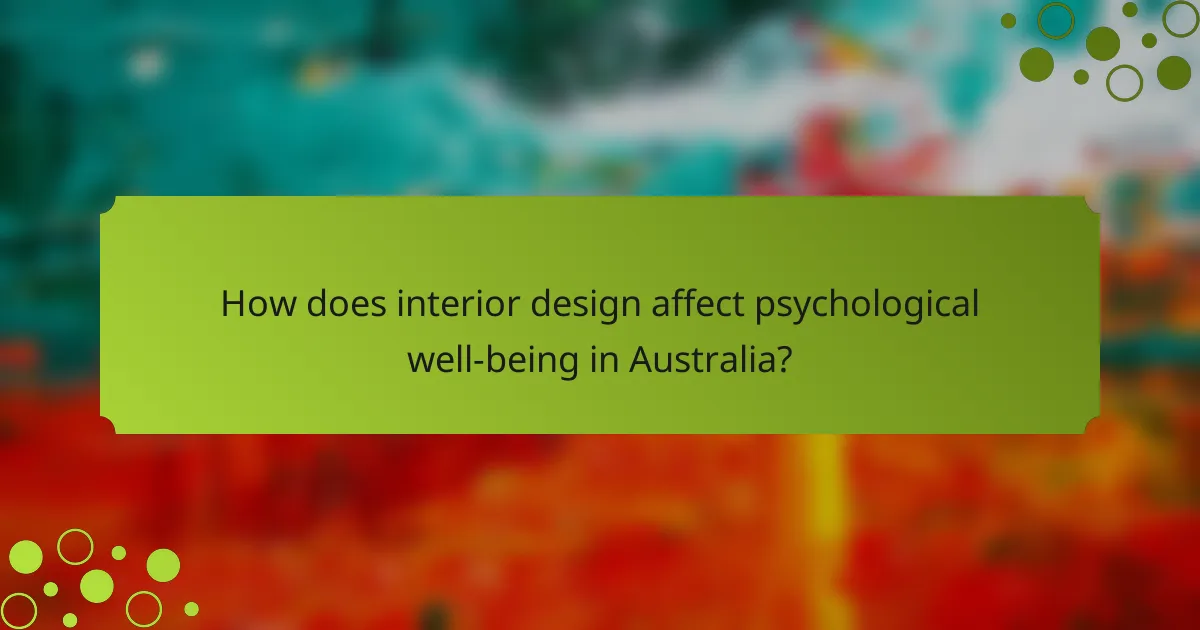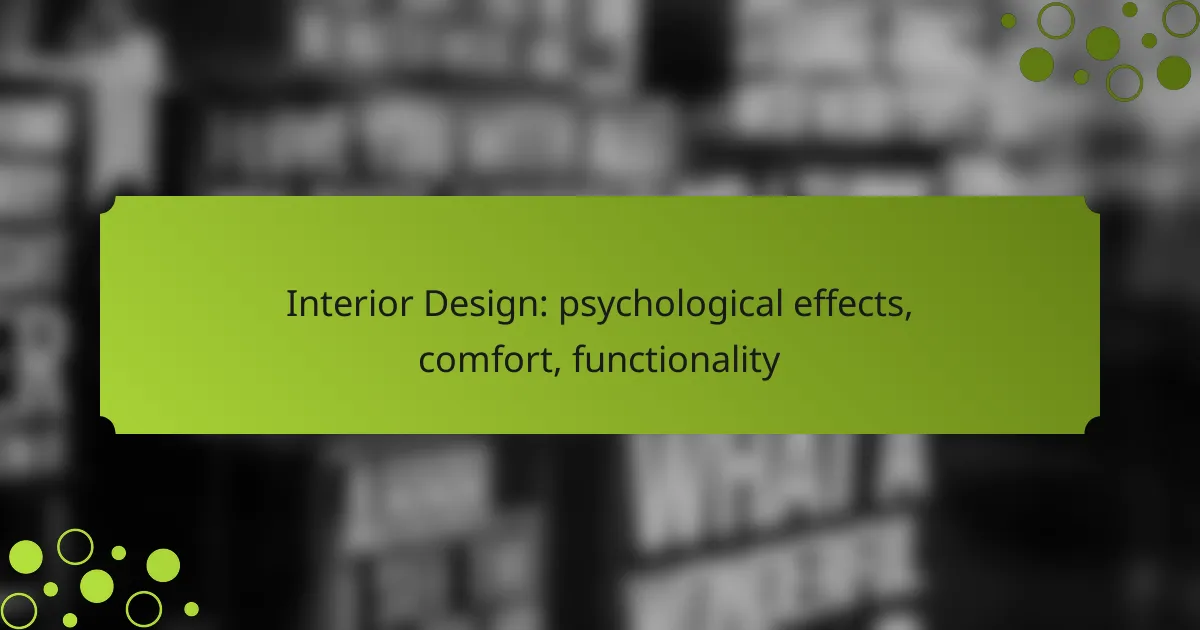Interior design plays a crucial role in shaping our psychological well-being by creating environments that prioritize comfort and functionality. By carefully considering elements such as ergonomics and textiles, designers can enhance mood and reduce stress, ultimately fostering positive interactions within a space. A successful design balances aesthetic appeal with practical usability, ensuring that spaces not only look good but also meet the needs of their occupants.

How does interior design affect psychological well-being in Australia?
Interior design significantly influences psychological well-being in Australia by shaping environments that promote comfort and functionality. Thoughtful design choices can enhance mood, reduce stress, and create spaces that foster positive interactions.
Color psychology in interior spaces
Color psychology plays a crucial role in how individuals perceive and interact with their environments. For instance, warmer colors like reds and oranges can evoke energy and excitement, while cooler tones such as blues and greens promote calmness and relaxation. In Australian homes, using a balanced palette can create a harmonious atmosphere that supports mental well-being.
When selecting colors, consider the purpose of each space. For example, a vibrant kitchen may benefit from energizing colors, while a bedroom should lean towards soothing shades to encourage restfulness. Experimenting with accent walls or decor can also provide a refreshing touch without overwhelming the overall design.
Impact of layout on mood
The layout of a space significantly impacts mood and functionality. Open floor plans can foster social interaction and a sense of community, while more segmented layouts may provide privacy and quiet. In Australian homes, balancing openness with designated areas for relaxation can enhance both comfort and social engagement.
When designing a layout, consider traffic flow and the placement of furniture. Avoid cluttered pathways to promote ease of movement, and arrange seating to encourage conversation. This thoughtful approach can create inviting spaces that support positive emotional experiences.
Use of natural light for mental health
Natural light is essential for mental health, as it influences mood and overall well-being. In Australia, maximizing natural light can help combat seasonal affective disorder and boost energy levels. Incorporating large windows, skylights, or reflective surfaces can enhance the brightness of interior spaces.
To optimize natural light, position mirrors strategically to reflect sunlight and avoid heavy drapes that block illumination. Consider using light, airy fabrics for window treatments to maintain brightness while ensuring privacy. These adjustments can create a more uplifting environment that supports mental clarity and emotional stability.

What are the key elements of comfort in interior design?
The key elements of comfort in interior design include ergonomics, textiles, and the overall functionality of the space. These factors work together to create an environment that promotes relaxation and well-being while meeting the practical needs of its users.
Ergonomics in furniture selection
Ergonomics plays a crucial role in selecting furniture that enhances comfort. When choosing chairs, sofas, and desks, consider their height, depth, and lumbar support to ensure they fit the user’s body properly. For instance, a chair should allow feet to rest flat on the floor and provide adequate back support to prevent strain during prolonged use.
Additionally, adjustable furniture can cater to different body types and preferences. Look for options like height-adjustable desks or reclining chairs that allow users to customize their seating position for optimal comfort. Avoid overly soft or deep seating that can lead to poor posture.
Textiles and their role in comfort
Textiles significantly influence the comfort level of a space through their texture, warmth, and aesthetic appeal. Soft fabrics like cotton, linen, and wool can create a cozy atmosphere, while synthetic materials might offer durability and ease of maintenance. Choose textiles that are pleasant to the touch and suitable for the intended use of the space.
Layering textiles, such as using cushions, throws, and area rugs, can enhance comfort by adding warmth and softness. Consider the color and pattern of textiles as well; calming colors and subtle patterns can contribute to a serene environment. When selecting textiles, ensure they are easy to clean and maintain, especially in high-traffic areas.

How does functionality influence interior design choices?
Functionality significantly impacts interior design choices by prioritizing how spaces are used and ensuring they meet the needs of their occupants. Effective design balances aesthetics with practical use, enhancing comfort and usability in everyday life.
Space optimization techniques
Space optimization techniques focus on maximizing the utility of available areas, making them feel larger and more efficient. Strategies include using vertical storage solutions, such as shelves and cabinets that reach the ceiling, and employing mirrors to create an illusion of depth.
Consider open floor plans that allow for fluid movement between areas, reducing clutter and enhancing accessibility. Utilizing multifunctional spaces, like a home office that doubles as a guest room, can also make the most of limited square footage.
Multi-purpose furniture solutions
Multi-purpose furniture solutions are essential for creating versatile living spaces, especially in smaller homes. Items like sofa beds, extendable dining tables, and storage ottomans can serve multiple functions, reducing the need for excess furniture.
When selecting multi-purpose pieces, prioritize durability and ease of transformation. Look for furniture that complements your decor while providing practical benefits, such as a coffee table that converts into a workspace or a bench with hidden storage.

What are the prerequisites for effective interior design?
Effective interior design requires a clear understanding of client needs, preferences, and budget constraints. These elements form the foundation for creating spaces that are not only aesthetically pleasing but also functional and comfortable.
Understanding client needs and preferences
To design effectively, it is crucial to gather detailed information about the client’s lifestyle, tastes, and specific requirements. Conducting interviews or surveys can help identify their priorities, such as the desired ambiance, color schemes, and types of furnishings.
Consider creating a mood board or visual references to align your vision with the client’s expectations. This collaborative approach ensures that the final design resonates with their personal style while meeting practical needs.
Budget considerations for design projects
Establishing a clear budget is essential for any interior design project. Clients should outline their financial limits early on to guide decisions regarding materials, furnishings, and services. A typical range for residential projects might be anywhere from a few thousand to tens of thousands of dollars, depending on the scope of work.
It’s important to communicate potential costs and prioritize spending on key elements that will have the most significant impact. Clients should be aware of common pitfalls, such as underestimating costs or overlooking hidden expenses like installation fees or permits. A well-structured budget can help avoid these issues and ensure a smoother design process.

What emerging trends are shaping interior design in Australia?
Emerging trends in Australian interior design focus on sustainability, smart technology, and biophilic elements. These trends aim to enhance comfort, functionality, and the overall well-being of inhabitants while reflecting a growing awareness of environmental impact.
Sustainable materials and eco-friendly design
Sustainable materials and eco-friendly design are becoming essential in Australian interiors. Designers are increasingly using reclaimed wood, recycled metals, and low-VOC paints to minimize environmental footprints. Choosing materials that are durable and sustainably sourced can also lead to long-term cost savings.
When selecting materials, consider certifications like Green Star or the Global GreenTag, which indicate environmentally friendly options. Additionally, incorporating energy-efficient appliances and fixtures can further enhance the sustainability of a space.
Smart home technology integration
Smart home technology integration is transforming how Australians interact with their living spaces. Features like automated lighting, smart thermostats, and security systems not only improve convenience but also enhance energy efficiency. These technologies can often be controlled remotely, allowing for greater flexibility and control over home environments.
When implementing smart technology, prioritize compatibility and ease of use. Look for systems that can integrate with existing devices and provide user-friendly interfaces. Consider starting with a few key features, such as smart lighting or a thermostat, to gradually enhance your home.
Biophilic design principles
Biophilic design principles focus on incorporating natural elements into interior spaces to promote well-being. This trend emphasizes the use of natural light, plants, and organic materials to create a calming atmosphere. In Australia, where outdoor living is valued, blending indoor and outdoor spaces can significantly enhance comfort and functionality.
To apply biophilic design, consider adding large windows, indoor gardens, or natural textures like stone and wood. Aim for a balance between nature and modern design, ensuring that spaces feel inviting and connected to the environment. Regularly maintaining plants and ensuring adequate natural light can further enhance these principles.
